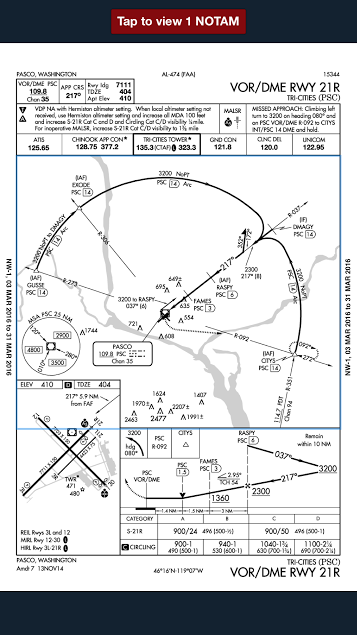The nice thing about the question including the arc, though, is that you can reasonably be assured obstacle clearance while ON the arc segment at or above the published altitude (even though you're flying it "backwards"). But you're right... not being on the arc could bring additional concerns (if MSA is above the published altitude for the arc).
Good point. Have to take all info into account.
@jesse essentially did this to me at night by failing stuff just when I was getting cocky. Ha.
*In my head* I didn't know if I was still on the arc or not. He coached me through figuring that out and continuing the arc without the DG (he knew I had a penchant for not cross referencing the mag compass because I thought looking up there was "cheating" but you have to!) and then we chatted the rest of the way around the arc on "what would you really do?" if you found yourself messing around on an arc not quite sure of the aircraft location due to a failure, a brain fart, or whatever.
The lesson was a good one. Climb and figure out how to "go missed" in a safe direction and live to fight another day, in the real world.
For added fun, he pointed out a lighted tower off of our right wing (it was a left arc) that was *above* us as we went by. It was a "safe" FAA approved distance away from the arc itself, but a few miles and you'd find it, heading the wrong direction...
Which makes your point about the arc and its published altitude being obstacle free... If you know you're on it...
I was ****ed that I let him "gotcha" me that easily. But that was his job... Ha. Got my attention for sure.
To be honest, it probably also highlighted something else -- I doubt if given the option, that willfully choosing the DME arc in pitch black nowhere Nebraska single pilot and at 1AM would have been a smart ADM move if it were a real-world flight and not training, if other approach options were available. I'm usually not 100% on my game at 1AM and I know it.

(Which in the end probably made a lot of that middle of the night IFR training harder and more useful to see how I react to being fatigued -- something not many pilots actively seek out during training. Can't cheat as easily with a peek in nowhereville at night, can't completely shake the sleepies and yawns, might not notice a real world gyro failure as easily as some guy reaching over to cover the thing up... And you have to do it right or splat yourself over a corn field... It'll make you think hard about whether you'd launch at sunset into IMC, a statistically higher way to die... I highly recommend folks do a late night IFR training flight sometime with a night owl instructor, assuming the risk level of flying a single at night is "okay" with you both. There's always that problem, too. It teaches you some things about yourself you won't notice during daytime when you're 100% present and on top of things. Things you should learn in a controlled environment and not behind the power curve someday later when you decided "oh, it's only a short flight and the weather looks like it'll hold...")


